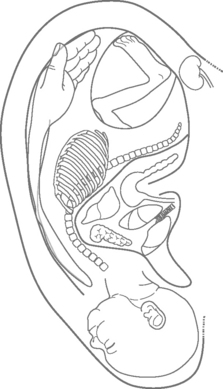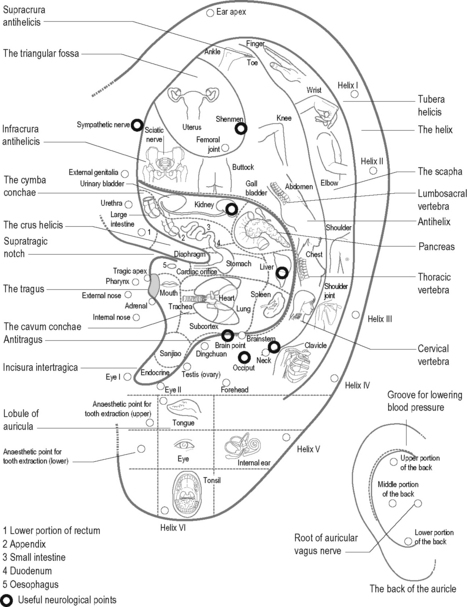12 Pulling it together
The Western therapist
The Western approach is summed up perfectly by the following quotation:
Acupuncture is a valuable method of complementary medicine with broad application in neurology. It is based on the experiences of traditional Chinese medicine as well as on experimentally proven biological (biochemical and neurophysiological) effects. Acupuncture-induced analgesia is mediated by inhibition of pain transmission at a spinal level and activation of central pain-modulating centers by release of opioids and other peptides that can be prevented by opioid antagonists (naloxone). Modern neuroimaging methods (functional MRI) confirmed the activation of subcortical and cortical centers, while transcranial Doppler sonography and SPECT showed an increase of cerebral blood flow and cerebral oxygen supply in normal subjects. Clinical experience and controlled studies confirmed the efficacy of acupuncture in various pain syndromes (tension headache, migraine, trigeminal neuralgia, posttraumatic pain, lumbar syndrome, ischialgia, etc.) and suggest favorable effects in the rehabilitation of peripheral facial nerve palsy and after stroke. Appropriate techniques, hygiene safeguards and knowledge of contraindications will minimize the risks of rare side effects of acupuncture which represents a valuable adjunction to the treatment repertoire in modern neurology. There is sufficient evidence of acupuncture to expand its use into conventional medicine and to encourage further studies of its pathophysiology and clinical value [2].
Although broadly encouraging, this raises a number of questions, the first being safety. Are we certain that acupuncture is safe? We do have results from a couple of very important safety trials, mentioned elsewhere in this book [3, 4], which support clinical practice and we also have additional anatomical work where skeletal anomalies have been examined and confirmed for prevalence. The two most important are the possibility of a sternal foramen at the level of CV 17 Shanzhong, and the thinning and occasional hole in the subspinal area of the scapula [5]. Once aware of the existence of these problems, and recognizing that the general bulk of muscle tissue can be greatly diminished in neurological disease, needling can be adjusted to avoid inflicting damage to the patient in any way.
Other safety issues are concerned with the physiological actions of acupuncture, such as increases in blood flow and velocity, sudden changes in blood pressure, unrealistic expectations produced by pain relief or euphoric responses to needling. Reviews of safety have concluded that, while acupuncture is not free of adverse events, they are rare, and it remains a relatively safe procedure [6].
It is also worth remembering that some of the recorded side-effects of acupuncture can be positive, the chief among them being described in a study of acupuncture as used by Swedish physiotherapists as ‘a pleasant feeling of fatigue’ [7].
Western supporting techniques
Ear acupuncture
The ancient Chinese recognized that some channels passed around or through the ear and described all the Yang meridians as having some connection but had not fully appreciated the reflexes involved. Nogier on the other hand spent many years studying the ear and slowly built up his concept of the ‘man in the ear’, in which he described a human fetus in an upside-down position with the head in the region of the earlobe and the limbs towards the top of the ear (Figure 12.1).

Figure 12.1 • ‘The man in the ear’ according to Nogier.
(From Hopwood V. Acupuncture in Physiotherapy. Oxford: Butterworth-Heinemann, 2004, p. 142.)
Nogier postulated that if there is a change in the body system due to pathology then a corresponding change can be shown in the ear, on the appropriate region. In the case of pain the areas where pain is felt in the body have been shown to have a high correlation with tenderness in the points on the ear that correspond with the sites. Oleson et al. provided the statistical evidence for these defined regions with a 74% accuracy rate in defining the musculoskeletal pains of 40 patients [8]. This applies to many kinds of pathology, not just pain [9]. The area occupied on the ear surface is proportional to that in the cortex, so the upper limb, particularly the hand and face, seems well represented.
The standardization of nomenclature for ear acupuncture points has been slow: the two main schools, that of Nogier and the TCM point locations, have now been joined by the work of Frank and Soliman [10, 11] who built on the original Nogier extended work which described three basic phases – mesodermal, ectodermal and endodermal. The theory underlying this division is that the ear is composed of three different kinds of tissue in the developing embryo and each of these types is involved in differing somatotropic responses relating to the ear. Further, the different phases are associated with acute, intermediate and chronic pain conditions. An acupuncture atlas [12] just gives all the points with little or no explanation, leading to much confusion among students.
The Chinese ear charts differ quite radically from those produced by Nogier, leading to considerable confusion among acupuncturists (Figure 12.2). There are many points on the TCM ear, located by way of a grid system and requiring a fine location skill. Chinese texts recommend the use of the points according to TCM principles, i.e. the Kidney point to treat bones, but since this appears to be a true reflex system this use is not supported scientifically.

Figure 12.2 • Chinese map of ear points
(from Hopwood V. Acupuncture in Physiotherapy. Oxford: Butterworth-Heinemann, 2004, p. 14.)
More important is the nerve supply to each part of the structure. The ear has an abundant innervation, being supplied by the sensory fibres of the trigeminal, facial and vagus nerves. The endings of these nerves are closely interwoven and can influence many distant body areas. Bourdiol gives an explanation based on embryology, emphasizing the fact that these nerves travel only a short distance to the reticular formation of the brainstem [13].
There are several ways of classifying the points. Oleson and Kroening [14] suggested nomenclature that depends on whether the points are located on raised, depressed or hidden areas in the ear. Otherwise the Chinese or Nogier maps are commonly used.
The mechanism appears to be the same as in the rest of the body. Ear acupuncture has been shown to affect the endorphin concentration and to be reversible by naloxone [15]. The study by Simmons and Oleson investigated changes in dental pain threshold after electroacupuncture stimulation to the ear, showing that true electroacupuncture produced a significant rise in the pain threshold while the placebo, using inappropriate ear points, did not.
Points derived from the Chinese system of ear acupuncture are regularly used in drug addiction withdrawal programmes. The National Acupuncture Detoxification Association protocol uses five points – Shenmen, Liver, Lung, Sympathetic and Kidney – and is supported by some research [16]. This combination of points can produce profound relaxation in distressed patients so it has an application beyond that of drug withdrawal. It may owe more to the fact that the pinna is richly innervated and offers a good site to stimulate the central nervous system in a general way, but it has been utilized successfully in palliative care patients with serious anxiety states.
Research
The original work supporting this theory was performed by Oleson et al. [8]. In a blinded trial it was found that body pathology in patients could be detected with 74% accuracy by testing for tenderness in the ear and measuring changes in the electrical resistance of the skin. The result was highly statistically significant and anecdotal evidence from the same trial indicated that old pathology that the patients themselves had forgotten about was also detected.
Stay updated, free articles. Join our Telegram channel

Full access? Get Clinical Tree








